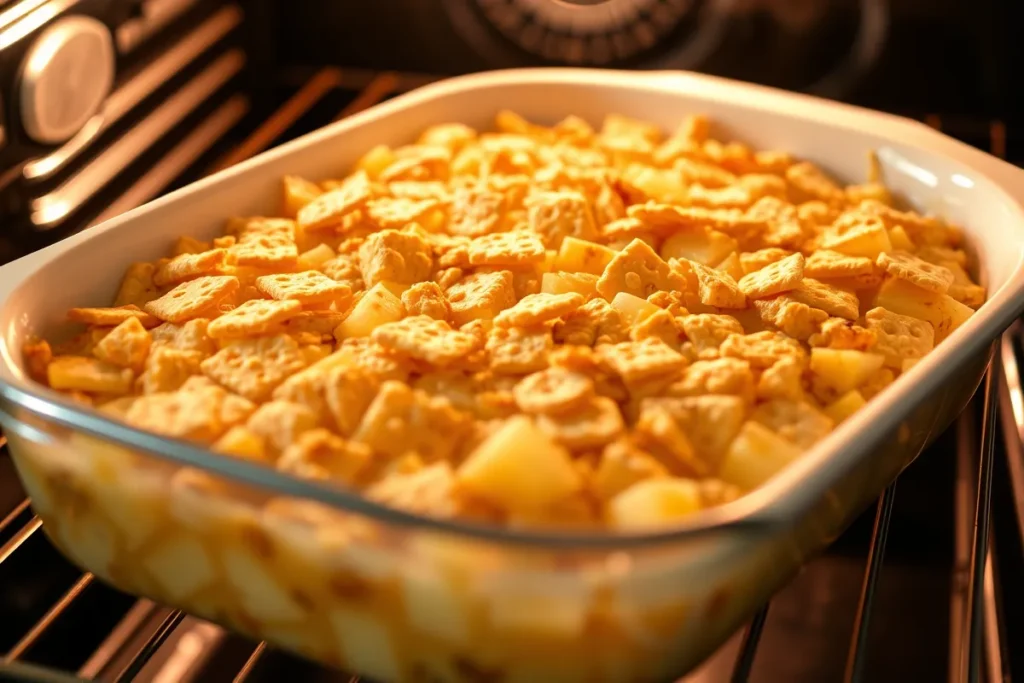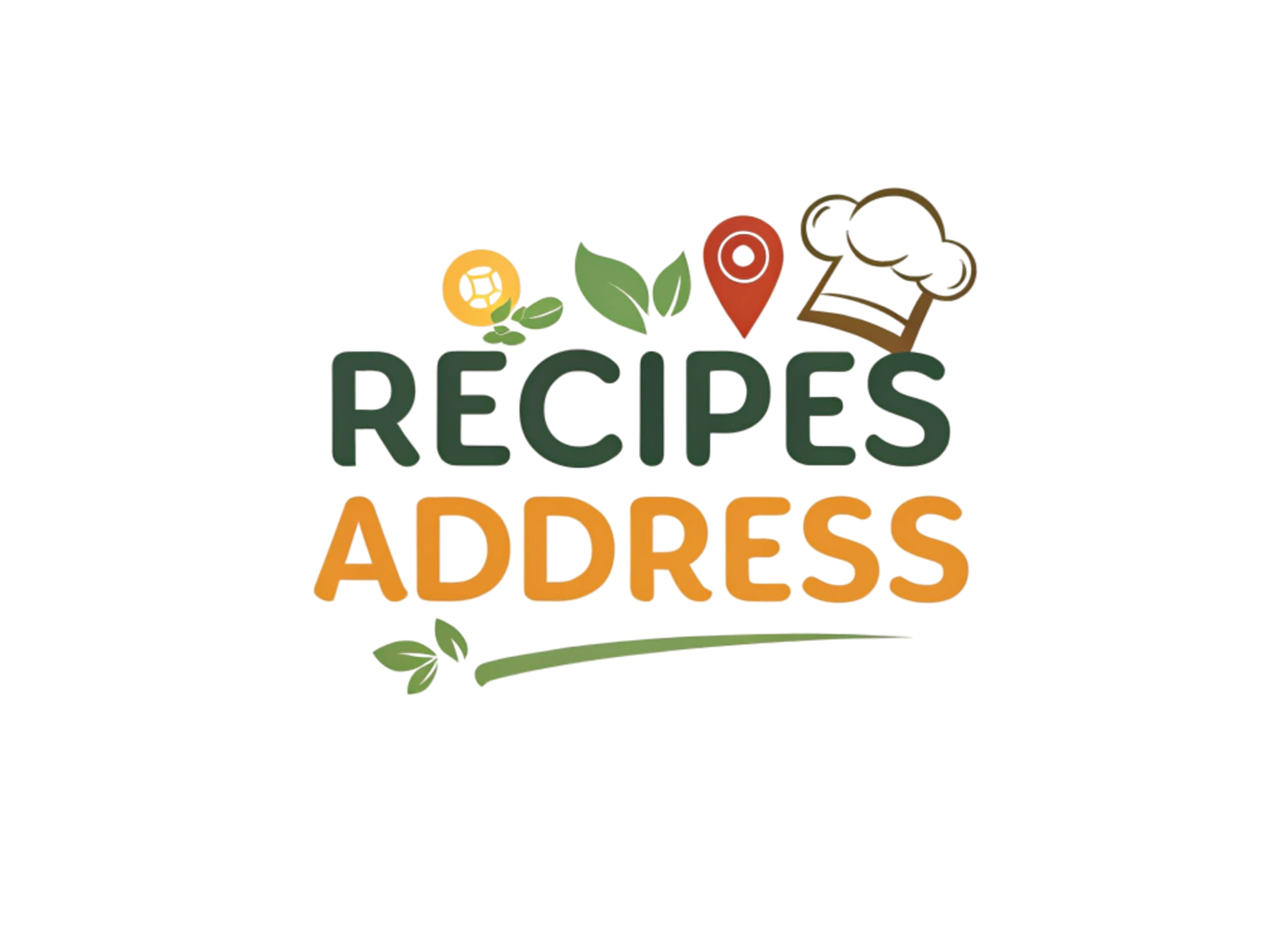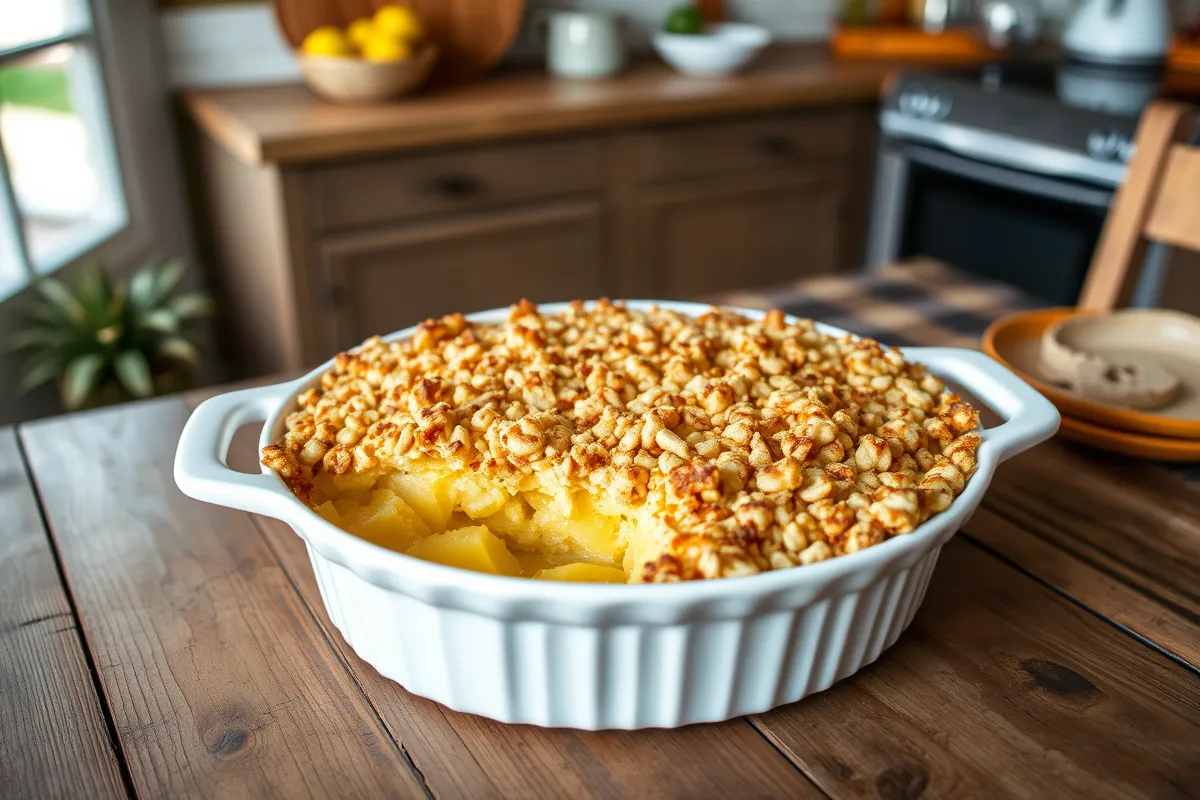Introduction to Pineapple Casserole
Pineapple casserole is a dish that brings together the perfect balance of sweet and savory flavors. Loved by many, it has become a staple at holiday gatherings, family dinners, and potlucks. This comforting recipe combines juicy pineapple, tangy cheddar cheese, and a buttery cracker topping for a truly unique culinary experience.
Why is pineapple casserole so special? For starters, it’s incredibly versatile. Whether served as a side dish alongside roasted ham or enjoyed as a dessert with its sweet notes, it fits almost any occasion. Additionally, the preparation is straightforward, making it an excellent choice for both beginner and experienced cooks.
In this article, we’ll take a deep dive into what makes pineapple casserole a standout dish. We’ll explore its history, ingredients, and step-by-step preparation. Plus, you’ll learn useful tips and variations to personalize this crowd-pleaser. If you’ve ever wondered how to make the best pineapple casserole, you’re in the right place.
History and Origins of Pineapple Casserole
Pineapple casserole is deeply rooted in Southern cuisine, where comfort foods reign supreme. This dish, a harmonious blend of sweet and savory, reflects the creative ways Southern cooks have historically combined unexpected ingredients to create memorable meals. Its origins are tied to the abundance of pineapple during the mid-20th century, when canned fruits became a kitchen staple in American households.
Traditionally, pineapple casserole was served as a side dish, especially during holidays like Easter and Thanksgiving. Its ability to complement main dishes such as ham or turkey made it a favorite for large gatherings. The addition of cheddar cheese and buttery crackers further enhanced its appeal, adding a layer of richness and texture.
Over the decades, pineapple casserole has maintained its place as a beloved recipe in Southern cookbooks. While its exact origins are unclear, it is believed to have emerged as a result of the Southern tradition of pairing sweet and salty flavors. Today, it continues to be a cherished recipe that brings nostalgia and warmth to dinner tables across the country.
With its enduring popularity, pineapple casserole proves that the simplest ingredients can come together to create something truly exceptional.
Traditional Ingredients for Pineapple Casserole
To make a delicious pineapple casserole, you need a handful of basic ingredients. These simple yet flavorful elements come together to create a dish that is both comforting and satisfying.
- Canned Pineapple
The star of the show is, of course, pineapple. While fresh pineapple can be used, canned pineapple is often the preferred choice for its convenience and consistency. Both pineapple chunks and crushed pineapple are commonly used, and the choice depends on the texture you desire in your casserole. Canned pineapple is typically packed in syrup, which adds sweetness, but you can also find varieties packed in juice if you prefer a lighter option. - Cheddar Cheese
A sharp cheddar cheese is often used in pineapple casserole for its bold, tangy flavor. The combination of the rich cheese with the sweetness of the pineapple creates a delicious contrast. Some variations might use other types of cheese, but cheddar remains the most popular choice for this dish. - Sugar
Granulated sugar is an essential ingredient that enhances the sweetness of the pineapple. The sugar balances out the savory flavors from the cheese and buttery crackers, creating a well-rounded dish. - Ritz Crackers (or similar buttery crackers)
Ritz crackers are traditionally used to top the casserole, adding a crispy and buttery layer that contrasts perfectly with the soft, baked pineapple mixture. The crackers should be crushed before being sprinkled on top of the casserole to form a crunchy crust during baking. - Unsalted Butter
It contributes to the creamy texture of the casserole and helps the cracker topping crisp up nicely during baking. Unsalted butter is typically used so you can control the level of salt in the dish.
These ingredients form the foundation of pineapple casserole, but variations abound. You might add nuts, marshmallows, or even spices to further personalize your dish.
Step-by-Step Preparation Guide for Pineapple Casserole
Making pineapple casserole is a straightforward process that requires minimal effort but yields a delightful dish. Below, we walk through the step-by-step instructions to ensure your casserole turns out perfect every time.

Preparing the Pineapple Mixture
Start by preheating your oven to 350°F (175°C). This ensures your casserole bakes evenly and comes out hot and bubbly. While the oven heats up, prepare your baking dish. A 9×13-inch dish is ideal for this recipe, allowing the ingredients to cook evenly and giving enough space for the casserole to expand.
Next, drain the canned pineapple thoroughly. This step is crucial to prevent excess moisture from making the casserole soggy. After draining, place the pineapple in a large mixing bowl. If you’re using crushed pineapple, consider pressing it with a spoon to extract even more juice.
Add sugar to the pineapple mixture and stir well. The sugar will enhance the natural sweetness of the pineapple and provide a balance to the savory flavors that come later from the cheese and crackers. Mix until the sugar is fully dissolved.
Adding the Cheese
Once the pineapple and sugar mixture is ready, stir in the shredded sharp cheddar cheese. The cheese not only adds flavor but also gives the casserole a creamy texture when baked. You can use as much or as little cheese as you prefer, but a generous amount is often recommended for maximum flavor.
Preparing the Cracker Topping
For the topping, crush about 1 sleeve of Ritz crackers into small pieces. You can do this easily by placing the crackers in a zip-top bag and crushing them with a rolling pin, or you can use a food processor for a finer texture. Once crushed, place the crackers in a separate bowl and melt about ½ cup of butter.
Mix the melted butter with the crushed crackers, making sure all pieces are coated evenly. This buttery mixture will create the crispy, golden topping that adds texture to the casserole.
Assembling the Casserole
Now that your pineapple mixture and cracker topping are prepared, it’s time to assemble the casserole. Begin by spreading the pineapple and cheese mixture evenly across the bottom of your prepared baking dish. Smooth out the surface to ensure even baking.
Next, sprinkle the buttery cracker mixture generously over the top of the casserole. Make sure the crackers are spread evenly to create a uniform crust.
Baking the Casserole
Place the assembled casserole into the preheated oven and bake for 30-35 minutes. Keep an eye on it towards the end, and look for a golden-brown, crispy topping. The casserole should be bubbly around the edges, indicating that it’s fully cooked.
Once baked, remove it from the oven and let it cool for a few minutes before serving. The sweet, tangy pineapple combined with the sharp cheddar cheese and buttery cracker topping creates a harmonious dish that’s sure to impress.
Variations and Modern Twists for Pineapple Casserole
While the traditional pineapple casserole is a crowd-pleaser on its own, there are many creative variations you can try to put a modern spin on this classic dish. These adaptations allow you to experiment with flavors and ingredients, ensuring the casserole suits your taste preferences or dietary needs.
Using Fresh Pineapple Instead of Canned
Although canned pineapple is typically the go-to for this dish due to its convenience and consistent sweetness, using fresh pineapple can elevate the flavor and texture of the casserole. Fresh pineapple provides a more vibrant and tangy taste that can make the dish feel lighter and more natural. If you opt for fresh pineapple, be sure to chop it into small, bite-sized pieces and drain any excess juice to avoid sogginess.
Different Cheese Options
While sharp cheddar cheese is the traditional choice, there are other cheeses that can add a unique twist to your pineapple casserole. For a milder flavor, you can use mozzarella, or for a creamier texture, opt for cream cheese or gouda. A combination of cheeses, such as a mix of cheddar and Monterey Jack, can also provide a rich and complex flavor profile. The key is to find the right balance between the cheese’s sharpness and the sweetness of the pineapple.
Adding Nuts for Extra Crunch
For an additional layer of texture, consider adding nuts to your casserole. Chopped pecans, walnuts, or almonds pair beautifully with the sweetness of the pineapple and the buttery cracker topping. Simply sprinkle the nuts on top along with the cracker mixture, or stir them directly into the pineapple mixture for a more integrated crunch. The nuts add a savory element that complements the sweetness of the fruit.
Experimenting with Spices
Although pineapple casserole is often made with just sugar and cheese, adding a hint of spice can take it to the next level. Ground cinnamon or nutmeg can bring a warm, comforting flavor to the dish, especially if you’re making it for the holidays. A pinch of cayenne pepper can also add a touch of heat, creating an intriguing contrast with the sweetness of the pineapple.
Making it Gluten-Free
For those who are gluten-sensitive or follow a gluten-free diet, it’s easy to adapt the recipe. Instead of Ritz crackers, use gluten-free crackers or panko breadcrumbs. There are many gluten-free cracker options available on the market, allowing you to maintain the crunchy topping without compromising on flavor. Additionally, double-check that the other ingredients you use, such as cheese and sugar, are certified gluten-free.
Vegan and Dairy-Free Alternatives
If you’re following a plant-based diet, you can still enjoy pineapple casserole by making a few substitutions. Swap out the dairy-based cheese for a vegan cheese alternative that melts well. Use dairy-free butter in place of regular butter, and check that the crackers you choose are free of dairy. You can even make your own vegan-friendly cracker topping by combining gluten-free crackers with coconut oil instead of butter.
These variations allow you to get creative with your pineapple casserole while still keeping the essence of the dish intact. Feel free to experiment and make the recipe your own.
Serving Suggestions for Pineapple Casserole
Pineapple casserole is a versatile dish that can be served in many different ways, depending on the occasion and your personal preferences. Whether you’re serving it as a side dish or a dessert, there are numerous ways to pair it with other foods to enhance the meal.
Pairing with Main Dishes
One of the most popular ways to serve pineapple casserole is as a side dish, especially alongside meats like roasted ham, turkey, or grilled pork chops. The sweet and savory nature of the casserole makes it an ideal accompaniment to rich, hearty meats. The tanginess of the pineapple balances the saltiness of the meats, creating a harmonious flavor profile that pleases the palate.
For a festive meal, pineapple casserole pairs wonderfully with other holiday favorites such as mashed potatoes, green beans, and cornbread. The casserole adds a touch of brightness and sweetness to a meal that might otherwise be filled with savory, heavier dishes.
Serving as a Dessert
Though pineapple casserole is typically served as a side dish, it can easily double as a dessert. The sweetness from the pineapple and sugar, combined with the richness of the cheese, creates a dessert-like quality that’s perfect for those who enjoy sweet and savory combinations. You can serve it warm with a scoop of vanilla ice cream or whipped cream for an indulgent treat that everyone will love.
Special Occasions and Potlucks
Pineapple casserole is a fantastic dish to bring to gatherings like potlucks, picnics, or holiday parties. Its ease of preparation and ability to serve a crowd make it a go-to recipe for any event. Whether you’re attending a Thanksgiving dinner, a family barbecue, or a church picnic, this casserole is sure to be a hit. It’s also a great dish to prepare ahead of time, allowing you to enjoy the event without worrying about last-minute cooking.
Presentation Tips
Although pineapple casserole is delicious, its visual appeal can elevate the dining experience. To make the dish more festive or appealing, try garnishing it with fresh herbs such as mint or parsley. A sprinkle of chopped nuts or additional grated cheese on top can add texture and make the casserole look more inviting. For an extra touch, you can serve it in individual ramekins, which are not only adorable but also make portion control easier.
Pineapple casserole’s versatility and ability to complement various main courses or desserts make it a perfect addition to almost any meal. Its balance of flavors will leave a lasting impression on your guests, no matter how you choose to serve it.
Nutritional Information and Considerations for Pineapple Casserole
Pineapple casserole is a delicious dish that offers a satisfying combination of flavors, but like many comfort foods, it can be calorie-dense. Below, we break down the approximate nutritional content of a typical serving and explore ways to make the dish healthier if desired.
Calories and Macronutrients
A standard serving of pineapple casserole (approximately 1/8th of the casserole) contains around 250-300 calories. The calorie count can vary depending on the exact ingredients used and portion sizes. Here’s a general breakdown of the macronutrients:
- Carbohydrates: Pineapple casserole is relatively high in carbohydrates, primarily due to the sugar and crackers. A single serving typically contains around 35-40 grams of carbs, which come from both the pineapple and the crackers.
- Fat: The casserole contains about 12-15 grams of fat per serving, most of which comes from the butter and cheese. This is an important consideration for those watching their fat intake.
- Protein: While not a high-protein dish, pineapple casserole does provide a small amount due to the cheddar cheese. Expect around 5 grams of protein per serving.
- Fiber: Due to the pineapple and crackers, a serving of pineapple casserole typically contains about 1-2 grams of fiber, which is modest compared to other dishes but still a helpful addition to your diet.
Making Pineapple Casserole Healthier
If you’re looking to lighten up the dish or make it more nutritious without sacrificing flavor, there are several options:
- Reduce Sugar: You can cut back on the sugar or use a sugar substitute like stevia or monk fruit to reduce the overall sweetness without compromising the texture of the casserole.
- Use Low-Fat Cheese: Opting for low-fat or reduced-fat cheese can help cut down on the fat content. While this will slightly alter the flavor, the sharpness of the cheddar still comes through and complements the pineapple well.
- Substitute with Whole Grain Crackers: Instead of using buttery Ritz crackers, try whole-grain or gluten-free crackers for a healthier, fiber-rich option. These substitutions won’t drastically change the casserole but will add extra nutrients.
- Use a Lighter Butter Alternative: If you’re trying to reduce fat and calories, consider using a butter substitute, such as light margarine or even coconut oil. These alternatives provide similar results while reducing the saturated fat content.
Frequently Asked Questions
Here are some commonly asked questions about pineapple casserole to help you perfect your dish and answer any lingering questions you might have.
Is pineapple casserole served as a side dish or dessert?
Pineapple casserole is typically served as a side dish, particularly at holiday meals like Thanksgiving or Easter, where it complements main dishes like ham and turkey. However, its sweet flavor and richness make it versatile enough to be served as a dessert as well, especially if you enjoy sweet and savory combinations.
How do I make pineapple casserole gluten-free?
To make a gluten-free version of pineapple casserole, simply substitute the regular crackers with gluten-free crackers or panko breadcrumbs. There are plenty of gluten-free options available that will provide the same crispy texture on top. Additionally, double-check that all other ingredients, like cheese and butter, are gluten-free.
Can I add other fruits to the casserole?
Yes, pineapple casserole is versatile and can be made with different fruits. You can experiment by adding fruits like peaches, mangoes, or even apricots. Just keep in mind that the sweetness and texture of the fruit will affect the overall flavor of the casserole. Be sure to adjust the sugar content accordingly to balance out the fruit’s sweetness.
With these FAQs, you should feel more confident in preparing and personalizing your pineapple casserole. If you have any other questions or need further clarification, feel free to reach out!
And For more Dessert Recipes, make sure you visit Our Dessert Category for plenty of savory delights.
Conclusion
Pineapple casserole is a unique and versatile dish that can easily become a favorite at any meal. Whether you serve it as a side dish alongside your main course or as a sweet dessert, its balance of sweet and savory flavors will surely impress your guests. With its combination of pineapple, cheddar cheese, and buttery cracker topping, this dish offers a comforting and delicious taste of Southern cuisine.
Throughout this article, we’ve explored the origins, ingredients, and preparation methods of pineapple casserole, along with a variety of ways to personalize the recipe. From adding fresh fruit and experimenting with different cheeses to making it gluten-free or vegan, the possibilities are endless. By following the steps provided, you can create a dish that fits your preferences and dietary needs.
Whether you’re preparing it for a holiday gathering, a casual dinner, or just as a family treat, pineapple casserole brings warmth and flavor to any occasion. Don’t hesitate to try out new variations or serving suggestions to make the dish your own.
Thank you for reading! Now that you have all the tools and knowledge to make a perfect pineapple casserole, it’s time to gather your ingredients and get baking!

